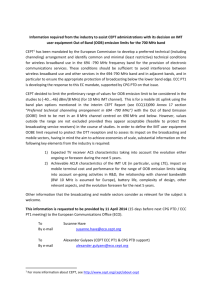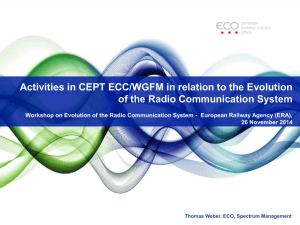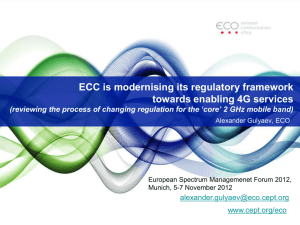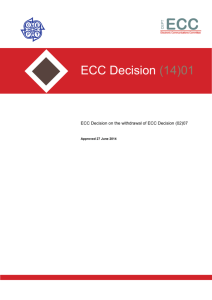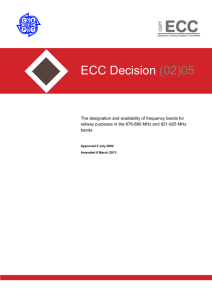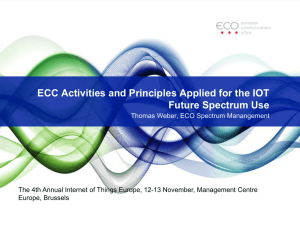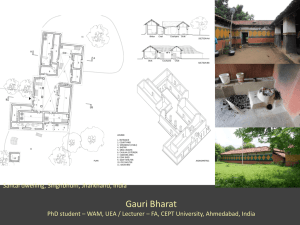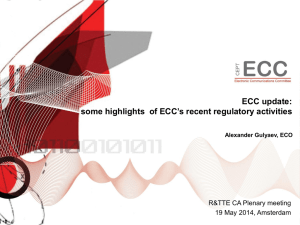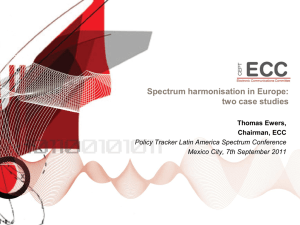a Major Step towards Enabling Mobile Broadband
advertisement
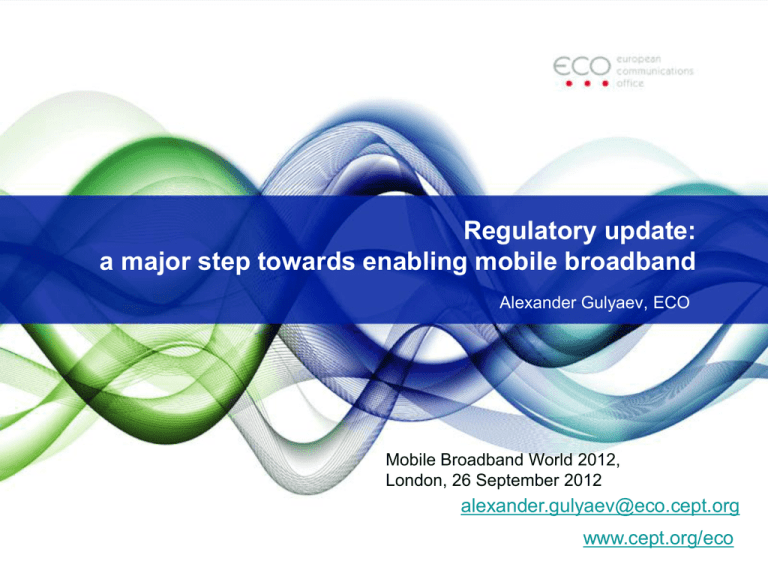
Regulatory update: a major step towards enabling mobile broadband Alexander Gulyaev, ECO Mobile Broadband World 2012, London, 26 September 2012 alexander.gulyaev@eco.cept.org www.cept.org/eco Outline • European regulatory landscape • Is it getting too tight in the current ‘mobile bands’? • 3.5 GHz – a future home for mobile broadband • What’s ahead? European regulatory framework for radio spectrum and equipment Read more at http://apps.cept.org/ eccetsirel/ Roles of the three European regulatory organizations European Commission: Single market issues Binding regulations based on the technical expertise of CEPT/ECC and harmonised standards of ETSI (27 Member States) CEPT/ECC: Consensus and voluntary character Spectrum designation to systems/applicatoins and technical conditions for its use (48 member countries) ETSI: European Harmonised standards (EN) for radio equipment ‘System Reference Documents’ (SRDoc) which inform and trigger much of the CEPT/ECC work (over 700 industry members and European naitonal regulators) CEPT/ECC: Strategic Plan Priority topics: • Digital dividend • Cognitive radio • Public Protection and Disaster Relief (PPDR) • Innovation above 40 MHz • Numbering and naming • Improve its own working processes EC: Radio Spectrum Policy Programme (RSPP) • Mobile broadband (1200 MHz) • Spectrum Inventory • Public protection and disaster relief (internal market) • Electricity production and distribution (Green...) • Wireless microphones and cameras • Foster different modes of spectrum sharing • Spectrum Trading (where flexible use available) Hard facts – the growth of mobile broadband Feb 2008 Jul 2009 Nov 2010 Source: ECC PT1 Report on mobile broadband, September 2011 (www.cept.org/ecc/eccpt1) European harmonised ‘mobile bands’ 800 MHz - Digital Dividend up to 60-65 MHz 900MHz - GSM/UMTS/LTE 50-70 MHz 1800MHz - GSM/UMTS/LTE 150 MHz 2 GHz - UMTS/LTE 160 MHz 2.6 GHz - LTE 190 MHz 3.4-3.8 GHz - BWA (fixed/mobile) 400 MHz RSPP: ”find 1200 MHz bandwidth” New services – new spectrum priorities • While discussions around the new mobile spectrum in the UHF-band (1st and 2nd Digital dividends) remain very politicized considering the social importance of low frequency ranges, these bands lack the capacity to meet demand for delivering mobile broadband applications to the mass market • New, really high-speed mobile services, such as enhanced Internet browsing, video streaming and video calls, require significantly greater channel bandwidths than 5 MHz (for example, 10, 20 and 40 MHz) and thus much more contiguous spectrum to accommodate the demand! (these requirements are technically justified in ITU-R Report M.2134) Where will the spectrum come from for mobile broadband? A unique opportunity : contiguous 2x200 MHz of radio spectrum at 3.5 GHz • WRC-07 identified the 3.4-3.6 GHz band for IMT • ECC also addresses the 3.6-3.8 GHz band for IMT • ITU-R: 6 IMT-2000 radio interfaces and 2 IMT-Advanced radio interfaces ensuring a competitive environment • ECC: even more neutral regulatory framework for MFCN: Mobile/Fixed Communications Networks (including IMT) ECO Report 03: actual national authorisations in the 3.5 GHz and in other ‘mobile bands’ Country Estonia Germany Ireland Italy Latvia Macedonia Norway Spain Sweden Number of operators 3400-3600 MHz 3600-3800 MHz Technology in use Licence duration, tradability 6 X X WiMAX 2012 X X 2021 X X WiMAX (FDD/TDD) FDD/TDD WiMAX/LTE BWA (FDD/TDD) Several regional, 3 national Several regional, 1 national 9 X 7 X 1 X Fixed WiMAX TDD 6 X FDD 4 X LMDS Several regional, 3 national X 1 X 2 X X fixed, nomadic, mobile 1 X X - X X Switzerland Portugal UK BWA (fixed) Fixed radio systems, FDD/TDD TDD in paried frequency arrangement • ECO Report 03 on licensing of ‘mobile bands’ in CEPT contains detailed information on national authorisations issued in CEPT countries in all ‘mobile bands’, from ‘first hands’! • Is the 3.5 GHz really a greenfield ? Largely YES! It’s a greenfield for mobile broadband 2017 2023 Local coverage Earliest: 2014 Latest: 2025 2017, tradable 2022, tradable (national/regional) April 2020 tradable (national) Earliest: 201. Latest: 2023, tradable 2015 non-tradable 2025 Regional 2018/no expiry date National 3.5 GHz Regulatory Framework: YESTERDAY and TODAY • ECC Recommendation (04)05 on “guidelines for accommodation and assignment of Multipoint Fixed Wireless systems in frequency bands 3400-3600 MHz and 3600-3800 MHz” • ECC Decision (07)02 on “the availability of frequency bands between 3400-3800 MHz for the harmonised implementation of Broadband Wireless Access (BWA) systems” • CEPT Report 15 on Least Restrictive Technical Conditions (LRTC) based on the “Block Edge Mask” concept for the 3.5 GHz band • EC Decision 2008/411/EC (binding for EU Member States) The ”Block Edge Mask” (BEM) concept • Block Edge Mask (in the licence): o “Technology neutral” o Applies to the entire operator’s spectrum block o Covers both in-block and out-of-block emissions o Different BEMs apply to terminals and base stations (may also vary between the bands and TDD and FDD modes) o Forms a part of authorisation for spectrum use • Spectrum Emission Mask (in the standard): o Technology specific (transmitter, channelling) o Ensure intra-system compatibility o Forms a part of equipment conformity assessment Footer copy here In-band BEM Power Limit Block Neighbour Own Licence Licence Frequency BEM vs. SEM • Flexibility is given to operators in how to comply with BEM Footer copy here 3.5 GHz Regulatory Framework: TODAY (1) • ECC Decision (11)06 on “harmonised frequency arrangements for mobile/fixed communications networks (MFCN) in the bands 3400 3600 MHz and 3600 - 3800 MHz” • ECC survey: 3600-3800 MHz is more intensively used by FSS (spaceEarth) than 3400-3600 MHz → separate frequency arrangements • Block size: 5 MHz (blocks can be combined within one channel) • The position for the 3400-3600 MHz band will be reviewed by end of 2013 in order to define the preferred (either TDD or FDD) arrangement • TDD mode would allow more efficient protection of FSS applications • TDD networks should be synchronized to avoid “restricted blocks” and large guard bands • Coordination of TDD networks should be managed at a national level 3.5 GHz Regulatory Framework: TODAY (2) Fig.1 Harmonised TDD frequency arrangement for the 3400-3600 MHz Fig. 2 Harmonised FDD frequency arrangement for the 3400-3600 MHz Fig. 3 Harmonised TDD frequency arrangement of the 3600-3800 MHz 3.5 GHz Regulatory Framework: now time to review the BEM • The existing Block Edge Masks for the 3.5 GHz were technically justified when there was no harmonized frequency arrangement and maximum flexibility was needed (e.g. for BWA deployments). • When harmonized frequency arrangements are adopted, there is no need for the unnecessarily tight BEM. • Therefore ECC decided, as a further step, to adjust those BEMs to the foreseen in the newly approved ECC Decision (11)06 future high data rate applications (including IMT), with larger channel bandwidths, in order to facilitate the development of affordable equipment, maximize the spectrum efficiency (e.g. by reduced guard bands) and thus maximize the usable amount of spectrum. 3.5 GHz Regulatory Framework: TOMORROW • Draft CEPT Report on the 3.5 GHz in response to the second EC Mandate (channelling arrangements + BEM): the Final Report will be submitted to the European Commission in November 2013 • Draft ECC Report on Block Edge Masks in the 3.5 GHz: a methodology agreed for the derivation of BEM • Draft ECC Report on “Practical guidance for TDD network synchronization”: the work will be limited to the “TDD vs. TDD synchronised” scenario (alternatively expensive additional filtering, site coordination or restricted blocks/guard-bands may be needed. The work is being carried out in ECC PT1, the CEPT/ECC expert group on MFCN (including IMT) Transition from the existing to the new regulatory framework at 3.5 GHz • The new regulatory framework for the 3.5 GHz (i.e. harmonised frequency arrangements and new, less tight BEM) is expected to be progressively implemented in CEPT countries • BWA systems based on 7 MHz channels have been deployed in some CEPT countries => the regulators need flexibility to adapt the current use of these bands to national circumstances • Regulatory measures may include: o refarming of the band (i.e. change of use) o renewal or extension of authorisations o withdrawal of authorisations where no system has been deployed o coordination between MFCN/BWA and FSS (where necessary) Coordination between MFCN/BWA and FSS • There are currently 170 fixed satellite earth stations authorized within the EU Member States (deployed on 78 sites). • For MFCN and FSS coordination, similar principles can be used as for BWA and FSS: BWA “central stations” are coordinated with the FSS earth stations. This implies that all the (fixed) terminal stations, operating under the control of central stations are consequently coordinated under the umbrella of the central stations (this typically requires to slightly extend the coordination distances). Participating in ECC work: how to join www.cept.org/ecc Coming update of the EC regulatory framework for the 3.5 GHz band When the remaining ECC work for the 3400-3800 MHz is finalised, yet another strand of work would be needed to align the current binding for EU Member States Commission Decision 2008/411/EC with the new technical conditions developed within ECC. But all these regualtory efforts appear to be absolutely necessary to ensure future common Europen market of high-speed mobile applications affordable to end users. Regulatory certainty at 3.5 GHz: what will it give us? • reduce the development manufacturing equipment; and implementation costs of • secure long term investments by providing economies of scale; • maximise the opportunities and benefits for end users; and • reduce the complexity in the spectrum cross border coordination What’s ahead? • WRC-15 has on its agenda new frequency bands for IMT (AI 1.1) and CEPT is the regulatory body for preparing the European position on this agenda item • The 3400-4200 MHz is proposed as one of the candidate new frequency bands for IMT and will be further studied within CEPT alexander.gulyaev@eco.cept.org www.cept.org/eco
